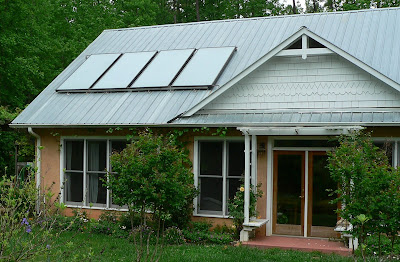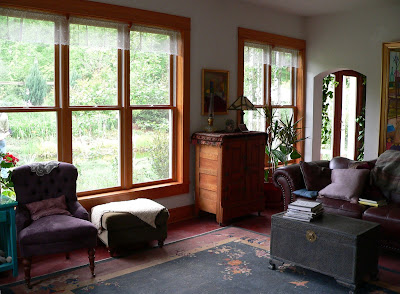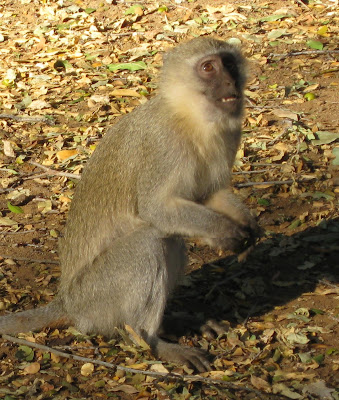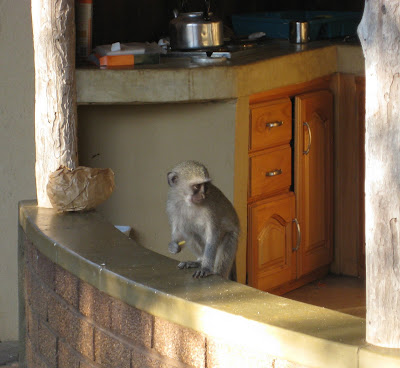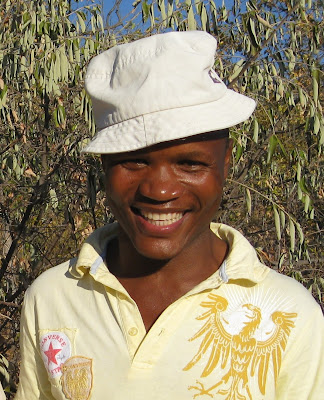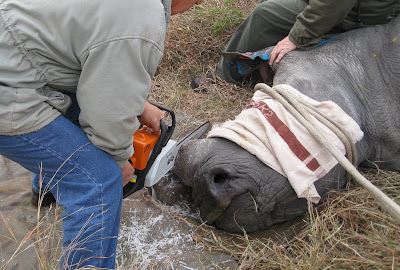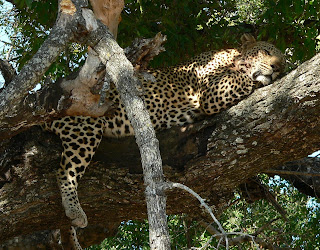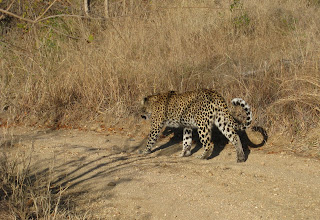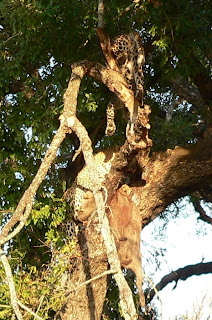Now linked to Google News – time-sensitive link
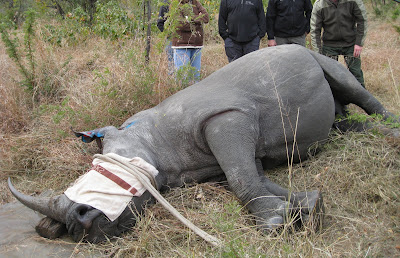 I was surprised at how simple it was. One of the men put his foot on the drugged rhino’s massive horn, pinning the horn to a wooden block on the ground.
I was surprised at how simple it was. One of the men put his foot on the drugged rhino’s massive horn, pinning the horn to a wooden block on the ground.

Then another guy revved up the chain saw and sawed the horn off her face, leaving a stump that protruded about 4 inches from the rhino’s skin.

A small plastic sheet under the rhino caught all the shavings, which were considerable.
Below, the shavings and the big horn.


The circular stump, head on, looked like a bulls-eye with its dark center.
Then the man with the chain-saw turned his attention to the second smaller horn, and sawed that off too, once again catching all the valuable shavings and flakes. The rhino was awake enough to flinch at that one, which was much closer to her eyes and ears.


The stumps of both horns on the mother rhino.
Rhino horns are made of compacted hair, so removing one shouldn’t hurt if the growth zone at the base isn’t touched. The horn will regrow about 2 inches a year, maybe twice that much if the animal is given protein supplements. A typical horn on an adult white rhino is about 22 inches.
As she lay on the ground, the rhino was grunting softly, laboring to breathe. Feeling the urge to comfort, I put my hand on her shoulder. Her skin was tough, like it looked, but I was surprised at how warm it felt- even warmer than human skin. No wonder they have so many parasites, the blood must be right under the surface.
Ken and I had been invited on this rhino capture by a couple of science friends while in Africa, in June. We’d watched while a helicopter took off with a vet, a vet tech, and a pilot to locate two rhinos from the air and to fire a tranquilizer dart from a rifle into each one.


One of the darts, after it was removed.
After a mother rhino and her year-old-baby were located and successfully darted, Ken and I and a group of other scientists had to find the fallen beasts in the dense African bush, not an easy task. The rhinos ran quite a ways before the drug brought them down. The plan was to take samples and measurements from the sedated pair, then inject an antidote to wake them and lead them into two cages on a flatbed truck.
The reason for the capture was that the rhino and her baby had been sold. They were moving from a wildlife preserve into private hands, to raise money for the preserve. The new private owner had requested that the mother have her horn removed to protect her from poachers. I had mixed feelings about that.
The new owner was operating under the theory that a rhino without horns is less likely to be killed by poachers, which may or may not be true – I don’t know. Rhino poaching is a real danger, having increased in southern Africa 3-fold between 2005 and August of 2009. In Kruger Park alone, 27 rhinos have been killed in 2009. Rhino horns stored at Addo National Park were stolen in a violent armed robbery in July of ’09. Just last night I got an email from a friend in South Africa that “Heidi,” the only white rhino at Thula Thula preserve, has just been shot and killed by poachers who hacked off her horn.
Rhino horn is extremely valuable, for two main markets. It’s sold to Asian countries, especially China, Taiwan, and South Korea, for use in traditional medicines. And it’s sold to Middle Eastern countries such as Yemen and Oman, where it’s used to make ornately carved handles for ceremonial daggers. We were told, while in Africa, that much of the rhino poaching is instigated by well-organized Asian syndicates, which may hire impoverished locals to do the dirty and dangerous work. It may take 3 days to track a rhino – which is invariably shot and killed before the horn is sawed or hacked off. An average-sized horn can sell for $24,000 on the black market. The scientists we went out with said the horns sell for $6,000 per kilo, and the mama’s horn that we saw weighed about 4 kilos.
So, does removing the horns protect rhinos from poaching? We were told by a variety of sources, including rangers and poaching guards, that removing horns from a rhino does little to protect it. Poachers will still go after a dehorned rhino and shoot it, because even the stump is valuable. And if the stump too is gone, we heard, the trackers will kill the rhino just so they won’t waste 3 days tracking the same useless animal again.
So back to the scene… the drugged mama and baby rhino…. as soon as we located the darted rhinos lying down and sedated, the group of scientists on the ground split into two teams to work respectively on the mother and baby. Cloths were tied around their eyes as blindfolds. A soft cloth ball the size of a tennis ball was stuffed into each ear to shut out sounds, to keep the animals calm.

Above, ear plugs for the mother (the black balls), put in place before the sampling and cutting began.
The teams took blood, hair, skin, and tissue samples, measured the animals’ temperature and pulse, inspected the teeth and various other body parts, and clamped ID tags to their ears.
Below, the sampling materials in the truck before the work began.

The pulse is checked (below).
One graduate student plucked green Amblyoma ticks from around each rhino’s anus. Below, the round ticks are visible in the skin creases. The mother’s tail is in the lower right of the photo below. I’m not sure what the white stuff is – maybe an antiseptic or a pesticide.
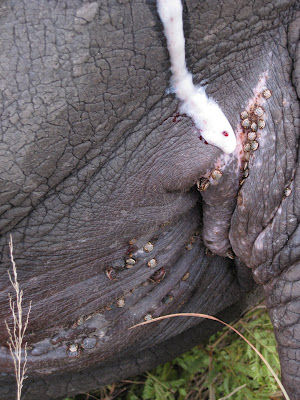 The ticks on most of their skin are plucked off by oxpeckers – birds that specialize in eating external parasites from large African herbivores. But I guess the birds can’t get to an anus that’s covered by a tail. I like almost all animals, including invertebrates, but I have to admit that the dozens of ticks around the mother’s moist anus were a bit unsavory.
The ticks on most of their skin are plucked off by oxpeckers – birds that specialize in eating external parasites from large African herbivores. But I guess the birds can’t get to an anus that’s covered by a tail. I like almost all animals, including invertebrates, but I have to admit that the dozens of ticks around the mother’s moist anus were a bit unsavory.
It was during this sampling and measuring that the mom’s horns were sawed off. The shavings and flakes, which were considerable, were saved because of their value. We were told that they will be stored in a secure vault. For what, or until when, I don’t know.
After all the sampling was done, a vet injected the antidote into the 10-yr-old mom and her yearling son, leaving the blindfolds in place.

After just a couple of minutes, the rhinos started to wake up. A bunch of people started trying to roll the rhinos so that their legs would be under them (the mother, below).

The rhinos were then urged and pushed and pulled into a sitting position (the mother, below).

Then the two animals were pulled and prodded toward the cages and truck that would take them to their new home (the mother, below).


As I ran beside the mother rhino, she passed saplings – and trampled them. She didn’t go around anything, but smashed everything in her way. Of course she couldn’t see where she was going. I felt sorry for her – she had no idea where her baby was, unless her keen sense of smell told her.
 We soon arrived at the cage for the mother. She was pulled with the rope, and pushed from behind , and walked easily enough into the cage.
We soon arrived at the cage for the mother. She was pulled with the rope, and pushed from behind , and walked easily enough into the cage.

The heavy cage door was lowered by a crane, and then the crane lifted the cage onto the flatbed truck. The baby was already in his cage on the truck, which had room for both cages (below).

Then it started to drizzle. So instead of driving the rhinos 80 some miles in a drizzle and risk their getting a respiratory infection, the decision was made to release them temporarily into a nearby holding pen that was forested and quite extensive. We drove there, the crane put the cages on the ground, and the blindfolds and earplugs were removed. Mom and babe were both released, and the rhinos rejoined one another immediately (below).

They then began to trot away from us (below).
 But baby stopped, and turned around to stare at us.
But baby stopped, and turned around to stare at us.
 “What the heck was that?,” he must have wondered. He may have never seen a human before. Someone clapped and yelled to shoo him and he turned to follow his mother (below).
“What the heck was that?,” he must have wondered. He may have never seen a human before. Someone clapped and yelled to shoo him and he turned to follow his mother (below).

Rhino conservation: the good and the bad
I didn’t know when we were in Africa how threatened or endangered the southern white rhino is. As it turns out, they are classified as Near Threatened (NT) on the IUCN Red List. I did know that they’re the largest land animal, after the African and Asian elephants. They’re larger than any other rhino species. We saw them on lots of outings in reserves – they were fairly common in southern Africa. I knew that white rhinos are really named for their “wide” and squarish upper lip. Africa’s black rhinos, which are much more rare and may be extinct in the wild, have a narrow prehensile upper lip that they use for browsing. Black rhinos are particularly vulnerable to poaching because they must have water daily and they return to the same water hole every day. Sometimes water holes are poisoned to kill the rhinos (and everything else that uses it).
Although the white rhino population in southern Africa is doing relatively well at present, they almost went extinct. In 1895, there were only 20 to 50 animals alive in the wild. Today, the population of white rhinos in southern Africa has grown to 17,500, with 750 more in captive breeding programs around the world, according to ARKive. I don’t know how they got from 50 to 17,500, but it’s a nice success story.
Still, white rhinos remain in danger due to habitat loss, the recent surge in poaching, and widespread poverty which affects human priorities. Africa is the only continent where poverty is increasing, due to human population growth, recurrent droughts, HIV, and a history of colonization and exploitation.
Poverty is a contributing factor
In some of the rural villages we visited in southern Africa, we were told that local people often enter national parks illegally to poach wildlife for food or for sale, and to gather firewood to use or to sell, when nearby sources are depleted. It’s the hierarchy of needs….if your kids are hungry, you do what you need to do to feed them. If you can. We also heard that rhino poachers are often shot on sight by poaching patrols. You can tell a rhino poacher, we were told, because they carry high caliber rifles – not the snares and homemade traps that local people use to catch smaller animals.
But the main driver of rhino poaching is the demand in consumer countries Recently, Vietnamese operators have been especially active in poaching rhinos from southern Africa, or in hiring local people to do it. That’s according to TRAFFIC, an international NGO that monitors illegal trade in wildlife. David Newton of TRAFFIC reported that “very senior members of the Vietnamese government claim to have been cured of certain terminal diseases by the use of rhino horn……so that seems to be where the demand is coming from.” Newton added that rhino horn has no medicinal qualities. It’s hard for me to stomach the news that government officials are promoting the poaching of rhinos. Do they know that rhino horns are no different chemically than hair??

A white rhino with its horns intact.
Do rhinos need the horns?
As I watched the mother rhino and her youngster led through this bewildering series of events that left the mother hornless, I wondered about their safety. Doesn’t she need her horn to protect the baby from predators? Maybe. But we were told, and observed for ourselves, that rhinos will trample whatever they want to trample. The trampling is more likely to kill you than the horn. Each dangerous animal has its way. A Cape Buffalo will pick you up with its horns and toss you into the air. A hippo “will bite you in half” we heard, if you get between the hippo and its river. But a rhino will just run right over you as though you weren’t even there. Each animal deserves distance and respect for different reasons! Rhinos do use their horns in social confrontations, but usually only in slight horn butting, false charges, and displays.
As the two wandered off into the trees after their ordeal, neither mom nor baby seemed to pay any attention to the absence of her horn – but who knows what was in her mind…or what their future will be. At least, I feel confident that she won’t wind up on a “trophy” shooting reserve. For who would pay thousands of dollars to hang a rhino head with a bulls-eye stump on his living room wall?
All text and photos by Sally Kneidel PhD of http://sallykneidel.com
Post script from a friend at TRAFFIC:
After I wrote this post, I got this e-mail from friend and colleague Richard Thomas, who works for TRAFFIC The Wildlife Monitoring Network:
“You may have seen that we [TRAFFIC] submitted a technical document, with WWF and IUCN, to CITES in July, highlighting the sudden alarming urge in rhino poaching — and issued a press release about its main findings that got a lot of publicity. The release is here, where you can download the
report too:
http://www.traffic.org/home/2009/7/9/poaching-crisis-as-rhino-horn-demand-booms-in-asia.html
Vietnam is certainly emerging as the country that’s driving the rhino
horn demand. Whilst you’re right to flag that poverty is a significant
factor in poaching of animals, research by TRAFFIC indicates that the
main driver is actually the demand for the products in the consumer
countries; and the Vietnam situation appears to be following that model.”
I amended my post above slightly after receiving this helpful point from
Richard Thomas.
Sources:
Personal communication with game control scientists, vet techs, biologists, poaching guards, rangers, wildlife guides in Africa.
ARKive: Images of Life on Earth
Rhino Horn the Cure for Serious Diseases? International Rhino Foundation, Aug 6, 2009
TRAFFIC: the wildlife monitoring network. www.traffic.org
More resources:
International Rhino Foundation:
http://www.rhinos-irf.org/white
IUCN SSC African Rhino Specialist Group:
http://www.rhinos-irf.org/afrsg
Keywords:: white rhino poaching threats to rhinos habitat loss Africa







